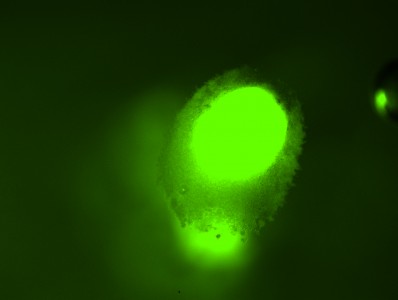NSU Newsroom
SharkBytes
Horizons
This version of NSU News has been archived as of February 28, 2019. To search through archived articles, visit nova.edu/search. To access the new version of NSU News, visit news.nova.edu.
This version of SharkBytes has been archived as of February 28, 2019. To search through archived articles, visit nova.edu/search. To access the new version of SharkBytes, visit sharkbytes.nova.edu.
Nova Southeastern University Researchers Studying How to Disrupt Bacteria to Treat Infections
Goal Is to Lessen Our Reliance on Antibiotics
FOR IMMEDIATE RELEASE
FORT LAUDERDALE/DAVIE, Fla. – Bacteria are everywhere. And despite widespread belief, not all bacteria are “bad.” However, to combat those that can cause health issues for humans, there has been an over-reliance on the use of antibiotics – so much so, that many of them are now proving ineffective due to bacteria developing increased resistance to them.
“More and more antibiotics are essentially becoming useless,” says Robert Smith, Ph.D., assistant professor in the Department of Biological Sciences at NSU’s Halmos College of Natural Sciences and Oceanography. “Even the most routine infections, such as ear infections that are often seen in children, are becoming more challenging and expensive to treat.”

A strain of Escherichia coli – better known as E. coli.
This notion isn’t new – just prior to winning his Nobel Prize in 1945, Alexander Fleming, the scientist who discovered antibiotics, warned that overusing them would lead to bacteria that were no longer killed by these drugs. Since then, scientists and bacteria have been locked in a deadly arms race. While scientists rush to discover new antibiotics, bacteria fight back by developing new tools to resist antibiotics. In recent years, the bacteria have been winning.
So this paradigm led researchers at NSU to take another look at how bacteria do what they do to see if there was another way to approach this issue. Researchers are now focusing on developing new ways to treat infections that reduce the use of antibiotics. And what the NSU researchers found, working with colleagues from Duke University and the University of Minnesota, was interesting.
Their findings are detailed in the March 27th edition of Scientific Reports (http://www.nature.com/articles/s41598-017-00588-9).
One way that bacteria infect people is by working together. First, they build a home called a biofilm, and then use chemicals to “talk with each other.” This allows the bacteria to coordinate an attack on the infected person. Led by NSU graduate Cortney Wilson, Smith’s lab recently discovered that by shaking the house that the bacteria have built, the ability of the bacteria to talk to one another is affected. Wilson earned her Master’s degree from NSU and is now at the University of Colorado, Boulder.
“We found that shaking the bacteria forced them to face a decision; do they want to grow, or do they want to cooperate,” Smith said. “And if we shook them at just the right frequency, we created enough confusion that the bacteria could do neither effectively.”
Smith notes that this strategy to prevent bacteria from talking to one another has promise in reducing the need for antibiotics. The team of scientists hope to begin testing their theory in more species of bacteria, and eventually in mice.
“It is a very exciting time for our research team. We are looking forward to building upon our very promising results and to moving our strategy into the clinic.”
Be sure to sign up for NSU’s RSS feed so you don’t miss any of our news releases, guest editorials and other announcements. Please sign up HERE.
###
About Nova Southeastern University (NSU): Located in beautiful Fort Lauderdale, Florida, Nova Southeastern University (NSU) is a dynamic research institution dedicated to providing high-quality educational programs at the undergraduate, graduate, and first-professional degree levels. A private, not-for-profit institution, NSU has campuses in Fort Lauderdale, Fort Myers, Jacksonville, Miami, Miramar, Orlando, Palm Beach, and Tampa, Florida, as well as San Juan, Puerto Rico, while maintaining a presence online globally. For more than 50 years, NSU has been awarding degrees in a wide range of fields, while fostering groundbreaking research and an impactful commitment to community. Classified as a research university with “high research activity” by the Carnegie Foundation for the Advancement of Teaching, NSU is 1 of only 50 universities nationwide to also be awarded Carnegie’s Community Engagement Classification, and is also the largest private, not-for-profit institution in the United States that meets the U.S. Department of Education’s criteria as a Hispanic-serving Institution. Please visit www.nova.edu for more information about NSU and realizingpotential.nova.edu for more information on the largest fundraising campaign in NSU history.
About NSU’s Halmos College of Natural Sciences and Oceanography: The college provides high-quality undergraduate (bachelor’s degree) and graduate (master’s and doctoral degrees and certificates) education programs in a broad range of disciplines, including marine sciences, mathematics, biophysics, and chemistry. Researchers carry out innovative basic and applied research programs in coral reef biology, ecology, and geology; fish biology, ecology, and conservation; shark and billfish ecology; fisheries science; deep-sea organismal biology and ecology; invertebrate and vertebrate genomics, genetics, molecular ecology, and evolution; microbiology; biodiversity; observation and modeling of large-scale ocean circulation, coastal dynamics, and ocean atmosphere coupling; benthic habitat mapping; biodiversity; histology; and calcification. The college’s newest building is the state-of-the-art Guy Harvey Oceanographic Center, an 86,000-square-foot structure filled with laboratories; offices; seminar rooms; an auditorium; and indoor and outdoor running sea water facilities. Please visit cnso.nova.edu for more information.
MEDIA CONTACT
April 12, 2017
Joe Donzelli | Office of Public Affairs
954-262-2159 (office) | 954-661-4571 (cell)
jdonzelli@nova.edu | www.nova.edu